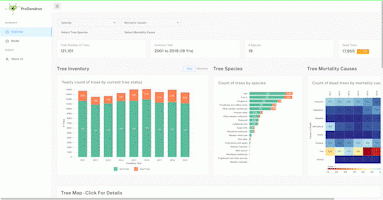Pro Dendron
Trees are vital to our environment as they remove carbon dioxide from the air and release oxygen back into the atmosphere. Global forests have captured around 20% of carbon emissions from human intervention in recent decades. Studies have revealed a shift in forest dynamics, with increases in tree mortality leading to faster turnover within forest regions globally. These shifts have resulted in fewer old-growth forests and less stable dynamics.
The causes of tree mortality include wildfires, droughts, insects, and disease and vary across locations and over time. While previous research has examined the impact of each cause, more work is needed to model interactions between these causes across species and regions and to make model predictions available to key stakeholders involved in reforestation efforts. We plan to model the complexities of tree mortality and build an interactive dashboard to provide information and visualizations about areas where trees have died, where trees will die in the near future, and the causes of these deaths.
This interactive platform will allow forest managers to plan preventative action when possible, plant new trees where needed, and plan for what trees are best to plant in different areas. Our product captures the complexities of tree mortality in the state of California and includes an interactive dashboard to provide information and visualizations about areas where trees have died and the factors that characterize tree death, aggregated by county. Most importantly - what is novel about our project is that we are improving mortality prediction in comparison to previous efforts while providing effective visualization of a complex dataset.
Our data is sourced from The United States Forest Service (USFS), Forest Inventory and Analysis (FIA) Program. We leveraged publicly available data collected for the state of California. We leveraged tree based ML algorithms, specifically Random Forest and XGBoost to predict tree mortality and cause of death. In addition, we identified which attributes were the most important in classifying. F1, Recall, Precision and Accuracy were used to evaluate model performance.Our top performing models were able to identify tree mortality and cause of death at 88% accuracy.
We’d like to thank industry experts who provided guidance and feedback; Glenn Christensen, Olaf Kuegler, Jane Terzibashian, Jeff Chambers, Matthew Potts, Van Butsic , Miranda Redmond, Kevin Lang. We’d also like to acknowledge our advisors Joyce Shen, Fred Nugen, and David Linnard.
To learn more about our findings click the link below!










